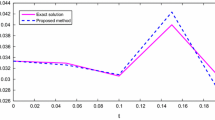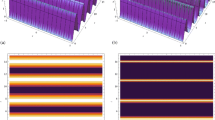Abstract
The Doi–Peliti method is effective for investigating classical stochastic processes, and it has wide applications, including field theoretic approaches. Furthermore, it is applicable not only to master equations but also to stochastic differential equations; one can derive a kind of discrete process from stochastic differential equations. A remarkable fact is that the Doi–Peliti method is related to a different analytical approach, i.e., generating function. The connection with the generating function approach helps to understand the derivation of discrete processes from stochastic differential equations. Here, a redundant basis interpretation for the Doi–Peliti method is proposed, which enables us to derive different types of discrete processes. The conventional correspondence with the generating function approach is also extended. The proposed extensions give us a new tool to study stochastic differential equations. As an application of the proposed interpretation, we perform numerical experiments for a finite-state approximation of the derived discrete process from the noisy van der Pol system; the redundant basis yields reasonable results compared with the conventional discrete process with the same number of states.


Similar content being viewed by others
Data Availability
Data used for the generation of this manuscript can be available from the authors upon reasonable request.
References
Doi, M.: Second quantization representation for classical many-particle system. J. Phys. A:Math. Gen. 9, 1465–1477 (1976)
Doi, M.: Stochastic theory of diffusion-controlled reaction. J. Phys. A: Math. Gen. 9, 1479–1495 (1976)
Peliti, L.: Path integral approach to birth-death processes on a lattice. J. Phys. 46, 1469–1483 (1985)
Sasai, M., Wolynes, P.G.: Stochastic gene expression as a many-body problem. Proc. Natl. Acad. Sci. USA 100, 2374–2379 (2003)
Bhattacharyya, B., Wang, J., Sasai, M.: Stochastic epigenetic dynamics of gene switching. Phys. Rev. E 102, 042408 (2020)
Ohkubo, J.: Duality in interacting particle systems and boson representation. J. Stat. Phys. 139, 454–465 (2010)
Täuber, U.C., Howard, M., Vollmayr-Lee, B.P.: Applications of field-theoretic renormalization group methods to reaction-diffusion problems. J. Phys. A:Math. Gen. 38, R79–R131 (2005)
Weber, M.F., Frey, E.: Master equations and the theory of stochastic path integrals. Rep. Prog. Phys. 80, 046601 (2017)
Altland, A., Simons, B.D.: Condensed Matter Field Theory, 2nd edn. Cambridge University Press, Cambridge (2010)
Droz, M., McKane, A.: Equivalence between Poisson representation and Fock space formalism for birth-death processes. J. Phys. A:Math. Gen. 27, L467–L474 (1994)
Deloubriére, O., Frachebourg, L., Hilhorst, H.J., Kitahara, K.: Imaginary noise and parity conservation in the reaction \(A + A \rightleftharpoons 0\). Physica A 308, 135–147 (2002)
Ohkubo, J.: One-parameter extension of the Doi-Peliti formalism and its relation with orthogonal polynomials. Phys. Rev. E 86, 042102 (2012)
Greenman, C.D.: Time series path integral expansions for stochastic processes. J. Stat. Phys. 187, 187 (2022)
Gardiner, C.: Stochastic Methods: A Handbook for the Natural and Social sciences, 4th edn. Springer, Berlin (2009)
Shiga, T., Uchiyama, K.: Stationary states and their stability of the stepping stone model involving mutation and selection. Probab. Theory Relat. Fields 73, 87–117 (1986)
Giardinà, C., Kurchan, J., Redig, F.: Duality and exact correlations for a model of heat conduction. J. Math. Phys. 48, 033301 (2007)
Giardinà, C., Kurchan, J., Redig, F., Vafayi, K.: Duality and hidden symmetries in interacting particle systems. J. Stat. Phys. 135, 25–55 (2009)
Carinci, G., Giardinà, C., Giberti, C., Redig, F.: Duality for stochastic models of transport. J. Stat. Phys. 152, 657–697 (2013)
Carinci, G., Giardinà, C., Giberti, C., Redig, F.: Dualities in population genetics: A fresh look with new dualities. Stochastic Processes and their Applications 125, 941–969 (2015)
Ohkubo, J.: Extended duality relations between birth-death processes and partial differential equations. J. Phys. A 46, 375004 (2013)
Greenman, C.D.: Duality relations between spatial birth-death processes and diffusions in Hilbert space. J. Phys. A:Math. Theor. 53, 445002 (2020)
Ohkubo, J., Arai, Y.: Duality in stochastic processes from the viewpoint of basis expansions. J. Stat. Mech. 2019, 063202 (2019)
Panja, D.: Effects of fluctuations on propagating fronts. Phys. Rep. 393, 87–174 (2004)
Risken, H.: The Fokker-Planck Equation: Methods of Solution and Applications, 2nd edn. Springer, Berlin (1989)
Starck, J.-L., Murtagh, F., Fadili, J.: Sparse Image and Signal Processing: Wavelets and Related Geometric Multiscale Analysis, 2nd edn. Cambridge University Press, New York (2015)
Van der Pol Jun. D.Sc, B.: LXXXVIII. On “relaxation-oscillations”. London, Edinburgh Dublin. Philos. Mag. J. Sci. 2, 978–992 (1926)
Črnjarić-Žic, N., Maćešić, S.: Mezić, I: Koopman operator spectrum for random dynamical systems. J. Nonlinear Sci. 30, 2007–2056 (2020)
Ohkubo, J.: Combinatorics for calculating expectation values of functions in systems with evolution governed by stochastic differential equations. J. Stat. Mech. 2021, 013401 (2021)
Hora, A., Obata, N.: Quantum Probability and Spectral Analysis of Graphs. Springer, Berlin (2007)
Gelß, P.: The tensor-train format and its applications: Modeling and analysis of chemical reaction networks, catalytic processes, fluid flows, and Brownian dynamics. Ph.D. thesis, Freie Universität Berlin (2017)
Ion, I.G., Wildner, C., Loukrezis, D., Koeppl, H., Gersem, H.D.: Tensor-train approximation of the chemical master equation and its application for parameter inference. J. Chem. Phys. 155, 034102 (2021)
Nicholson, S.B., Gingrich, T.R.: Quantifying rare events in stochastic reaction-diffusion dynamics using tensor networks. arXiv:2301.03717 (2023)
Kloeden, P.E., Platen, E.: Numerical Solution of Stochastic Differential Equations. Springer, Berlin (1992)
Acknowledgements
This work was supported by JST FOREST Program (Grant No. JPMJFR216K, Japan).
Author information
Authors and Affiliations
Corresponding author
Ethics declarations
Conflict of interest
The authors declare that they have no conflicts of interest.
Additional information
Communicated by Yariv Kafri.
Publisher's Note
Springer Nature remains neutral with regard to jurisdictional claims in published maps and institutional affiliations.
Appendix A: Numerical Details
Appendix A: Numerical Details
For the noisy van der Pol equation, we here use the parameters \(\epsilon = 1.0\) and \(\nu _{11} = \nu _{22} = 0.5\). The initial state is \(\varvec{x}_\textrm{ini} = (-0.1, 0.9)^\textrm{T}\), and the statistics at \(T=0.8\) are evaluated.
In the Monte Carlo simulations, we take the averages of 200 samples to evaluate the mean values of the statistics. We repeat this procedure 200 times to obtain the standard deviation of the means. The time-discretization with \(\Delta t = 10^{-3}\) is used in the Euler-Maruyama approximation [33].
For the conventional basis, the number of basis (states) is 15, as denoted in Sect. 4. We must specify the center positions \(\{\varvec{c}_d | d = 1, \ldots , 9\}\) for the redundant basis \(| \zeta _{0,d}\rangle \). First, we solve the van der Pol equation without noise, i.e., \(\nu _{11} = \nu _{22} = 0\). Second, we use equally-spaced \(25\times 25 = 625\) grid points in the range \([-2,2]\) on each dimension. Then, we tentatively set the center position \(\varvec{c}_d\) on each grid points, and the values of \(\exp (-\beta \Vert \varvec{x}(T)-{c}_d\Vert ^2)\) are numerically evaluated. Third, we select 9 grid points with the largest values; the selected points consist of the set \(\mathcal {S}_\textrm{r}\). Table 1 shows the selected center points. In the time-evolution of the derived discrete-state process, we use \(\beta = 4\) in \(| \zeta _{0,d}\rangle \).
Rights and permissions
Springer Nature or its licensor (e.g. a society or other partner) holds exclusive rights to this article under a publishing agreement with the author(s) or other rightsholder(s); author self-archiving of the accepted manuscript version of this article is solely governed by the terms of such publishing agreement and applicable law.
About this article
Cite this article
Takahashi, S., Ohkubo, J. Redundant Basis Interpretation of Doi–Peliti Method and an Application. J Stat Phys 190, 159 (2023). https://doi.org/10.1007/s10955-023-03180-w
Received:
Accepted:
Published:
DOI: https://doi.org/10.1007/s10955-023-03180-w




